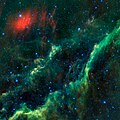Fichier:Menkhib and the California Nebula.jpg

Gréisst vun dëser Duerstellung: 600 × 600 Pixel. Aner Opléisungen: 240 × 240 Pixel | 480 × 480 Pixel | 768 × 768 Pixel | 1.024 × 1.024 Pixel | 2.048 × 2.048 Pixel | 4.095 × 4.095 Pixel.
Original Fichier (4.095 × 4.095 Pixel, Fichiersgréisst: 1,88 MB, MIME-Typ: image/jpeg)
Versiounen
Klickt op e bestëmmten Zäitpunkt fir déi respektiv Versioun vum Fichier ze kucken.
| Versioun vum | Miniaturbild | Dimensiounen | Benotzer | Bemierkung | |
|---|---|---|---|---|---|
| aktuell | 13:30, 12. Mee 2010 |  | 4.095 × 4.095 (1,88 MB) | Originalwana | {{Information |Description={{en|1=This infra-red image from NASA’s WISE (Wide-field Infrared Survey Explorer) features one of the bright stars in the constellation Perseus, named Menkhib (th |
Benotze vu Fichieren
Dës Säit benotzt dëse Fichier:
Globaalt Benotze vum Fichier
Dës aner Wikie benotzen dëse Fichier:
- Benotzt op ar.wikipedia.org
- Benotzt op en.wikipedia.org
- Benotzt op fa.wikipedia.org
- Benotzt op fr.wikipedia.org
- Benotzt op gl.wikipedia.org
- Benotzt op mk.wikipedia.org
- Benotzt op my.wikipedia.org
- Benotzt op pl.wikipedia.org
- Benotzt op pt.wikipedia.org
- Benotzt op ro.wikipedia.org
- Benotzt op ta.wikisource.org


